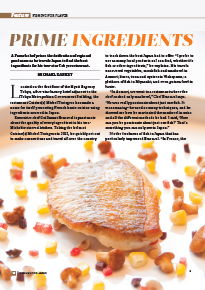Home > Highlighting JAPAN >Highlighting Japan July 2015>Fishing for Flavor
Highlighting JAPAN

Fishing for Flavor
Prime Ingredients
A French chef prizes the dedication of regional producers as he travels Japan to find the best ingredients for his two-star Tokyo restaurant.

Located on the first floor of the Hyatt Regency Tokyo, a five-star luxury hotel adjacent to the Tokyo Metropolitan Government Building, the restaurant Cuisine[s] Michel Troisgros has made a name for itself presenting French haute cuisine using ingredients sourced in Japan.
Executive chef Guillaume Bracaval is passionate about the quality of every ingredient in his two-Michelin-starred kitchen. Taking the helm at Cuisine[s] Michel Troisgros in 2012, he quickly set out to make connections and travel all over the country to track down the best Japan had to offer. “I prefer to use as many local products as I can find, whether it’s fish or other ingredients,” he explains. His travels uncovered vegetables, monkfish and mackerel in Aomori; limes, tuna and oysters in Wakayama; a plethora of fish in Miyazaki; and even guinea fowl in Iwate.
“In Aomori, we went to a restaurant where the chef cooked only mackerel,” Chef Bracaval says. “He was really passionate about just one fish. It was amazing—he used so many techniques, and he showed me how he marinated the mackerel in miso and all the different methods he had. I said, ‘How can you be passionate about just one fish?’ That’s something you can only see in Japan.”
It’s the freshness of fish in Japan that has particularly impressed Bracaval. “In France, the fishermen don’t keep their catch in water, so the fish die in the boat,” he says. “By the time you get them, almost one day has passed.”
While Paris is relatively close to Brittany and northern France, its distance limits the city’s ability to source fresh fish from other parts of the country. However, Japanese transport techniques make it possible to obtain fresh seafood from anywhere in Japan. “You receive everything so fresh. Here in the restaurant, when you receive prawns or lobsters, everything is in water, alive, and you just cook it. The quality of the product is amazing.”
The temperature of the local water also affects the quality of the fish, he says, with the same species tasting entirely different depending on where it’s caught. “When you arrive in Japan, you have to relearn almost all the fish. Even if it’s a fish you know, when you try it, you’ll say, ‘It’s really different from what I’ve had in France.’ ”
Bracaval’s top choice for his own cuisine is deep sea perch—a red, fatty fish locally known as kinki—which he first tasted at a three-Michelin-starred restaurant in Tokyo’s Shibuya area. “I ate the fish and I said, ‘Wow!’ ” he recalls, describing how he immediately returned to his restaurant to ask his staff to help him source some. Kinki is now a hotly anticipated item on the menu when it comes into season in October and November.
“Our kitchen moves and changes,” Bracaval says. “It’s really important for a chef to travel and see other things—to step back a little to see what’s good or what needs to change. If your nose is always down in your work, it’s impossible to see what else is out there.”
Ultimately, Chef Bracaval believes good ingredients come from dedicated producers. “When I use the ingredients of the people I met, I try to respect the producer,” he says. “It may just be a carrot, but how it’s grown, how the work is done, is really important. The grower does so many things, adding water and fertilizer, caring for each plant one at a time. He may be seventy years old, but he harvests all the vegetables one by one.”
Watching Bracaval manipulate cooking tweezers to set individual kernels of corn and pieces of diced tomato into a bed for a slice of grilled sea bream, it’s easy to see that his respect for local ingredients carries all the way from the producers to the dinner plates of his customers.
© 2009 Cabinet Office, Government of Japan






